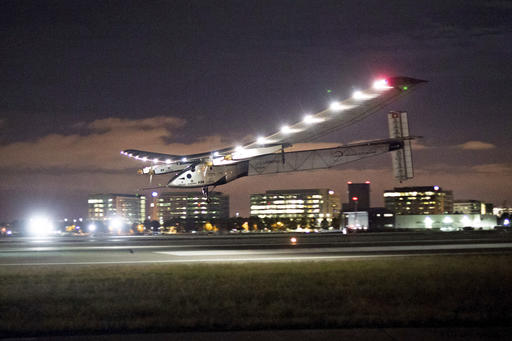
|
| In this April 23, 2016 file photo, Solar Impulse 2 lands at Moffett Field in Mountain View, Calif., completing the leg of its journey from Hawaii in its attempt to circumnavigate the globe. A solar-powered airplane that landed in Oklahoma last week is headed to Ohio on the latest leg of its around-the-world journey. The Swiss-made Solar Impulse 2 took off from Tulsa International Airport about 5 a.m. Saturday, May 21, 2016, with a destination of Dayton, Ohio. The flight was expected to take about 18 hours.(AP Photo/Noah Berger |
DAYTON, Ohio (AP) — A solar-powered airplane has touched down in the Ohio hometown of two of America's most well-known aviation pioneers on the latest leg of its around-the-world journey.
The Swiss-made Solar Impulse 2 landed late Saturday in Dayton, Ohio, where inventors Wilbur and Orville Wright grew up. The plane took off from Tulsa International Airport before 5 a.m. Saturday. The flight to Dayton International Airport took 17 hours.
The plane will be in Dayton until early next week, the Dayton Daily News reported. A spokeswoman for the plane's crew said an exact take-off time wouldn't be known until 24 hours in advance.
The globe-circling voyage began in March 2015 from Abu Dhabi, the capital of the United Arab Emirates, and made stops in Oman, Myanmar, China and Japan.
The plane is expected to make at least one more stop in the United States, in New York, before crossing the Atlantic Ocean to Europe or northern Africa, according to the website documenting the journey.
Niklaus Gerber, an air traffic control expert who's helping to plan the plane's routes, said during an interview live-streamed on the Solar Impulse 2 website, that the New York trip will be challenging. He said the plane will encounter air traffic from three busy airports — John F. Kennedy, La Guardia and Newark International.
During its most recent trips, the aircraft took off from Phoenix Goodyear Airport in Arizona at about 3 a.m. on May 13 and landed in Tulsa about 20 hours later.
It departed from northern California in the early hours of May 2 and landed at the airport southwest of Phoenix 16 hours later. Last month, it flew from Hawaii to California.
The Solar Impulse 2's wings, which stretch wider than those of a Boeing 747, are equipped with 17,000 solar cells that power propellers and charge batteries. The plane runs on stored energy at night.
Ideal flight speed is about 28 mph, although that can double during the day when the sun's rays are strongest.
The plane had a five-day trip from Japan to Hawaii and three-day trip from Hawaii to California's Silicon Valley.
The crew was forced to stay in Oahu, Hawaii, for nine months after the plane's battery system sustained heat damage on its trip from Japan.
Project officials say the layovers give the two Swiss pilots — Bertrand Piccard and Andre Borschberg — a chance to swap places and engage with local communities along the way so they can explain the project, which is estimated to cost more than $100 million.
The solar project began in 2002 to highlight the importance of renewable energy and the spirit of innovation.
Page created on 5/23/2016 4:34:59 PM
Last edited 5/23/2016 4:34:59 PM

